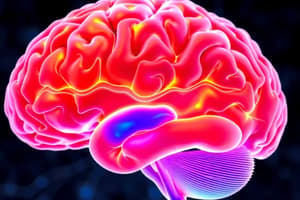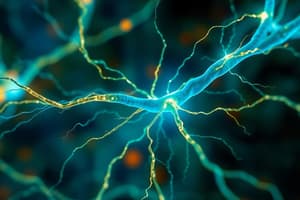Podcast
Questions and Answers
A patient presents with loss of pain and temperature sensation on the right side of the body, starting two segments below a spinal cord lesion on the left side. Which pathway is most likely affected?
A patient presents with loss of pain and temperature sensation on the right side of the body, starting two segments below a spinal cord lesion on the left side. Which pathway is most likely affected?
- Anterior spinothalamic tract
- Dorsal columns
- Anterior corticospinal tract
- Lateral spinothalamic tract (correct)
An elderly patient falls and sustains a hyperextension injury to the neck. Examination reveals weakness predominantly in the upper extremities and a 'cape-like' distribution of sensory loss. Which condition is most consistent with these findings?
An elderly patient falls and sustains a hyperextension injury to the neck. Examination reveals weakness predominantly in the upper extremities and a 'cape-like' distribution of sensory loss. Which condition is most consistent with these findings?
- Anterior cord syndrome
- Central cord syndrome (correct)
- Brown-Séquard syndrome
- Posterior cord syndrome
A patient has complete motor paralysis and loss of pain and temperature sensation below the level of a spinal cord injury, but retains proprioception and fine touch. Which vascular structure is most likely involved?
A patient has complete motor paralysis and loss of pain and temperature sensation below the level of a spinal cord injury, but retains proprioception and fine touch. Which vascular structure is most likely involved?
- Anterior spinal artery (correct)
- Vertebral artery
- Posterior spinal artery
- Radicular artery
Which of the following deficits would NOT be expected in a patient with complete occlusion of the anterior spinal artery?
Which of the following deficits would NOT be expected in a patient with complete occlusion of the anterior spinal artery?
A patient with central cord syndrome is most likely to experience the most pronounced motor deficits in which location?
A patient with central cord syndrome is most likely to experience the most pronounced motor deficits in which location?
Which of the following best describes the sensory loss pattern associated with a lesion of the spinothalamic tract?
Which of the following best describes the sensory loss pattern associated with a lesion of the spinothalamic tract?
A patient has lost the ability to perceive fine touch on their right leg, but still retains crude touch. Which of the following pathways is most likely damaged?
A patient has lost the ability to perceive fine touch on their right leg, but still retains crude touch. Which of the following pathways is most likely damaged?
In anterior cord syndrome, which sensory modalities are typically preserved?
In anterior cord syndrome, which sensory modalities are typically preserved?
A patient exhibits loss of fine touch and proprioception in their left leg, but normal sensation in their left arm. Where is the MOST likely location of a lesion?
A patient exhibits loss of fine touch and proprioception in their left leg, but normal sensation in their left arm. Where is the MOST likely location of a lesion?
Which of the following deficits would NOT be expected in a patient with a complete lesion of the anterior corticospinal tract at the T10 level?
Which of the following deficits would NOT be expected in a patient with a complete lesion of the anterior corticospinal tract at the T10 level?
A patient presents with a fluid-filled cavity affecting the central portion of the spinal cord in the cervical region. Which of the following is the MOST likely diagnosis?
A patient presents with a fluid-filled cavity affecting the central portion of the spinal cord in the cervical region. Which of the following is the MOST likely diagnosis?
A patient with Brown-Séquard syndrome experiences paralysis on the left side of their body and loss of pain and temperature sensation on the right side, beginning several dermatomes lower. Which side of the spinal cord is affected by hemisection?
A patient with Brown-Séquard syndrome experiences paralysis on the left side of their body and loss of pain and temperature sensation on the right side, beginning several dermatomes lower. Which side of the spinal cord is affected by hemisection?
Which of the following clinical findings is LEAST likely to be associated with syringomyelia affecting the cervical spinal cord?
Which of the following clinical findings is LEAST likely to be associated with syringomyelia affecting the cervical spinal cord?
Following a stab wound to the spinal cord, a patient presents with ipsilateral paralysis and loss of proprioception, along with contralateral loss of pain and temperature sensation. Which of the following is the MOST likely diagnosis?
Following a stab wound to the spinal cord, a patient presents with ipsilateral paralysis and loss of proprioception, along with contralateral loss of pain and temperature sensation. Which of the following is the MOST likely diagnosis?
Unlike the lateral corticospinal tract, the anterior corticospinal tract:
Unlike the lateral corticospinal tract, the anterior corticospinal tract:
A patient has damage to the dorsal columns of the spinal cord. Which sensory modalities will be MOST affected?
A patient has damage to the dorsal columns of the spinal cord. Which sensory modalities will be MOST affected?
A patient is diagnosed with syringomyelia that has expanded into the anterior horn cells of the cervical spinal cord. Which of the following clinical findings would be expected?
A patient is diagnosed with syringomyelia that has expanded into the anterior horn cells of the cervical spinal cord. Which of the following clinical findings would be expected?
In Brown-Séquard syndrome, the contralateral loss of pain and temperature sensation typically begins a few segments below the level of the lesion. This is because:
In Brown-Séquard syndrome, the contralateral loss of pain and temperature sensation typically begins a few segments below the level of the lesion. This is because:
Flashcards
Spinothalamic Tract
Spinothalamic Tract
Pathway transmitting pain, temperature, and crude touch sensations to the brain.
Lateral Spinothalamic Tract
Lateral Spinothalamic Tract
Division of the spinothalamic tract responsible for pain and temperature.
Anterior Spinothalamic Tract
Anterior Spinothalamic Tract
Division of the spinothalamic tract responsible for crude touch and pressure.
Central Cord Syndrome
Central Cord Syndrome
Signup and view all the flashcards
Central Cord Syndrome Symptoms
Central Cord Syndrome Symptoms
Signup and view all the flashcards
Anterior Cord Syndrome
Anterior Cord Syndrome
Signup and view all the flashcards
Anterior Cord Syndrome Characteristics
Anterior Cord Syndrome Characteristics
Signup and view all the flashcards
Anterior Cord Syndrome Prognosis
Anterior Cord Syndrome Prognosis
Signup and view all the flashcards
Anterior Corticospinal Tract
Anterior Corticospinal Tract
Signup and view all the flashcards
Dorsal Columns
Dorsal Columns
Signup and view all the flashcards
Fasciculus Gracilis
Fasciculus Gracilis
Signup and view all the flashcards
Fasciculus Cuneatus
Fasciculus Cuneatus
Signup and view all the flashcards
Syringomyelia
Syringomyelia
Signup and view all the flashcards
Cape-like Sensory Loss
Cape-like Sensory Loss
Signup and view all the flashcards
Brown-Séquard Syndrome
Brown-Séquard Syndrome
Signup and view all the flashcards
Ipsilateral Motor Paralysis (Brown-Séquard)
Ipsilateral Motor Paralysis (Brown-Séquard)
Signup and view all the flashcards
Ipsilateral Sensory Loss (Brown-Séquard)
Ipsilateral Sensory Loss (Brown-Séquard)
Signup and view all the flashcards
Contralateral Sensory Loss (Brown-Séquard)
Contralateral Sensory Loss (Brown-Séquard)
Signup and view all the flashcards
Study Notes
Spinothalamic Tract
- Responsible for transmitting pain, temperature, and crude touch sensations to the brain
- Composed of the lateral spinothalamic tract (pain and temperature) and the anterior (or ventral) spinothalamic tract (crude touch and pressure)
- Primary sensory neurons synapse in the dorsal horn after entering the spinal cord
- Second-order neurons cross the midline and ascend in the anterolateral aspect of the spinal cord
- Projects to the thalamus, which relays the information to the sensory cortex
- Lesions result in contralateral loss of pain and temperature sensation, typically beginning one to two segments below the lesion
Central Cord Syndrome
- Characterized by greater weakness in the upper extremities than in the lower extremities
- Often results from hyperextension injuries in older individuals with pre-existing cervical spondylosis
- Damage to the central part of the spinal cord affects spinothalamic tract fibers that decussate at that level
- Symptoms: disproportionate motor impairment in the upper extremities, sensory deficits more pronounced in the upper extremities, and varying degrees of bladder dysfunction
- Prognosis varies; many regain the ability to ambulate, but fine motor control in the hands may remain impaired
- Cape distribution of sensory loss is characteristic
Anterior Cord Syndrome
- Results from damage to the anterior two-thirds of the spinal cord
- Typically caused by infarction of the anterior spinal artery or direct trauma
- Characterized by complete motor paralysis below the level of the lesion, loss of pain and temperature sensation, and preservation of proprioception, vibration, and fine touch
- Prognosis for significant motor recovery is generally poor
- Bowel and bladder dysfunction are common due to the involvement of descending autonomic tracts
Anterior Corticospinal Tract
- One of the motor pathways that controls voluntary movement
- Originates in the cerebral cortex, descends through the brainstem, and enters the spinal cord
- Fibers do not decussate in the medulla, descending ipsilaterally in the anterior white matter of the spinal cord
- Fibers decussate at their target spinal segment and synapse with lower motor neurons in the anterior horn
- Primarily controls axial and girdle muscles, contributing to posture and gross motor movements
Dorsal Columns
- Sensory pathways that transmit fine touch, vibration, and proprioception from the periphery to the brain
- Primary sensory neurons ascend ipsilaterally in the dorsal columns (fasciculus gracilis and fasciculus cuneatus) after entering the spinal cord
- The fasciculus gracilis carries information from the lower extremities, while the fasciculus cuneatus carries information from the upper extremities
- Fibers synapse in the medulla at the nucleus gracilis and nucleus cuneatus
- Second-order neurons cross the midline and ascend in the medial lemniscus to the thalamus
- The thalamus relays the information to the sensory cortex
- Lesions result in ipsilateral loss of fine touch, vibration, and proprioception below the level of the lesion
Syringomyelia
- Characterized by the formation of a fluid-filled cavity (syrinx) within the spinal cord
- Most commonly occurs in the cervical region but can extend into the thoracic or lumbar regions
- The syrinx expands, compressing and damaging adjacent neural tissue
- Common causes include Chiari malformation, spinal cord tumors, trauma, and arachnoiditis
- Clinical manifestations vary, but classic findings include: cape-like distribution of sensory loss, muscle weakness and atrophy in the hands and arms, spasticity and hyperreflexia in the lower extremities, and bowel and bladder dysfunction
Brown-Séquard Syndrome
- Results from a hemisection (partial severing) of the spinal cord
- Typically caused by penetrating trauma or spinal cord tumors
- Characterized by: ipsilateral motor paralysis, ipsilateral loss of fine touch, vibration, and proprioception, contralateral loss of pain and temperature sensation (beginning a few segments below the level of the lesion)
- Additional findings include: ipsilateral Horner's syndrome (if the lesion is in the cervical or upper thoracic region) and bowel and bladder dysfunction
Studying That Suits You
Use AI to generate personalized quizzes and flashcards to suit your learning preferences.




